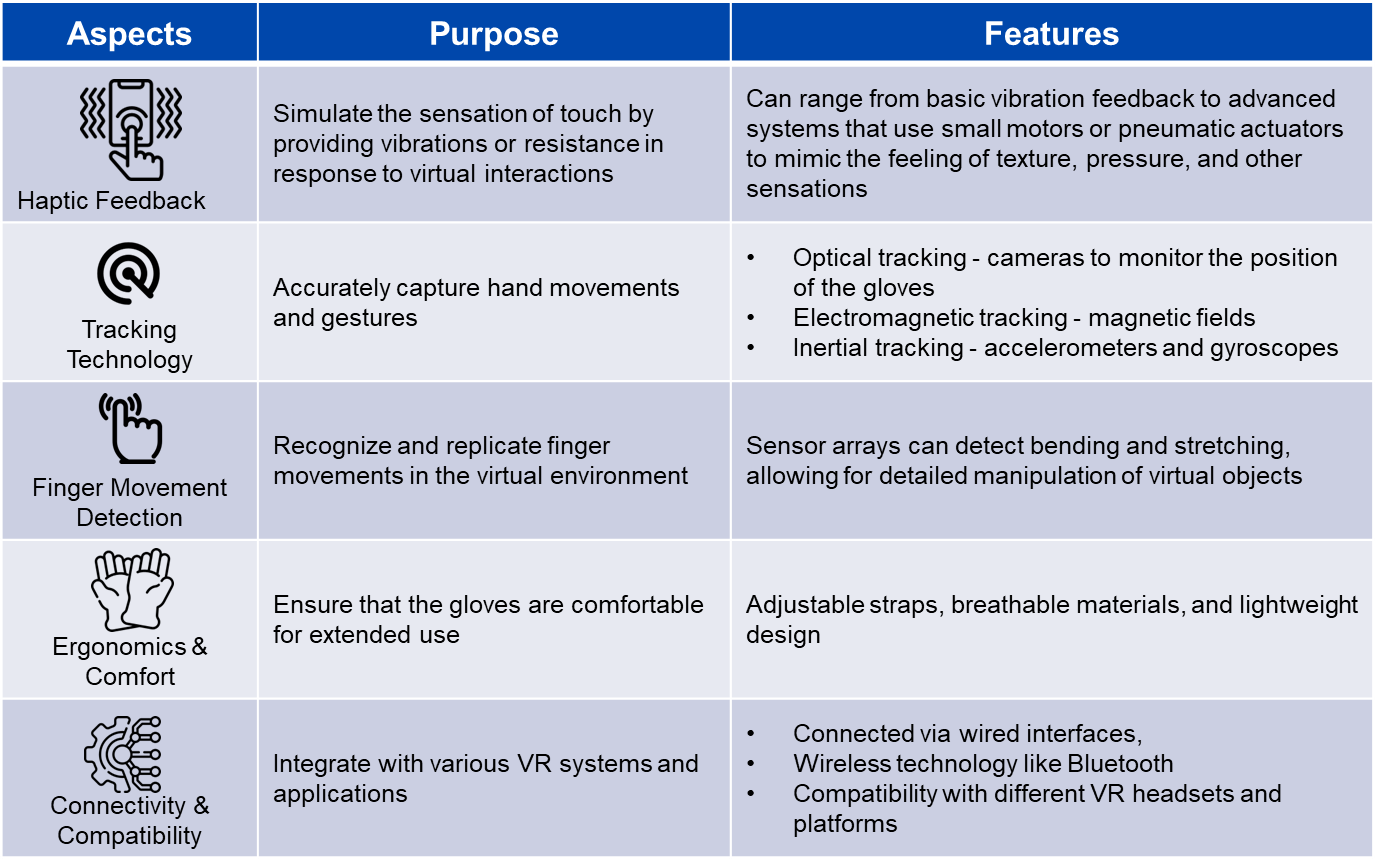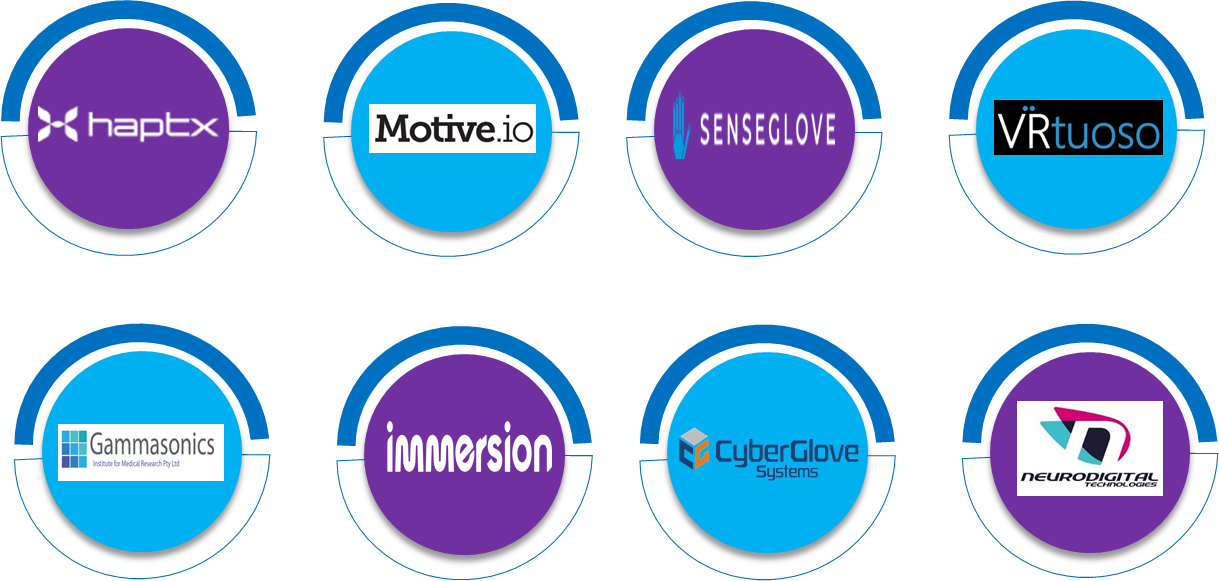Virtual reality (VR) is becoming an increasingly popular tool in different sectors. Yet, the application of virtual reality in the health sector has not been fully investigated. Nevertheless, great changes in training and treatment methods could be accomplished by integrating VR into healthcare. Virtual Reality (VR) gloves are creating noteworthy progress in the medical industry, offering various applications that enhance training and patient care. For instance, significant medical virtual reality glove developments have served multiple purposes, including improving patient care and teaching. Further growth drivers may include the infusion of more advanced technologies such as Augmented Reality (AR) and Artificial Intelligence (AI) with these gloves to enhance their capabilities, increasing market demand. Furthermore, this rise is contributed to by the increased use of virtual reality within the educational system and healthcare services. Nonetheless, high costs and technological restrictions on realistic haptic feedback are probable restraints on growth prospects for virtual reality medical gloves.
In the realm of VR, virtual reality gloves represent a thrilling passage to boost interaction in a spatially vivid manner through sensation. They are fascinating pieces of technology that aim to make the virtual environment more immersive and interactive. Gloves like these usually have sensors and actuators that track hand movements and provide tactile responses, enabling users to touch and move around virtual items as if they were actual ones. Integrating VR gloves into the medical arena is a big leap forward since it offers immersive and interactive solutions for enhancing training, treatment, and patient results. With advancing technologies, these applications are expected to grow much broader in scope and become more important components of healthcare delivery.
Trends
- Artificial Intelligence: AI is being used to enrich gesture recognition and predictive tracking to make interactions more intuitive
- Haptic Technology: New haptic technologies are emerging that can replicate intricate sensations such as texture, pressure, and temperature. Gloves with boosted dexterity and multi-modal haptic feedback could see a sharp surge in demand.
- Miniaturization and Accessibility: Wireless technologies and sensor downsizing developments are opening the opportunity for lightweight, cozy gloves for a wider range of users.

Figure 1: Trends in VR Gloves
Key Aspects of VR Gloves
Some key aspects of VR gloves are as follows:

Figure 2: Key Aspects of VR Gloves
Applications
Virtual Reality (VR) gloves are finding diverse applications in the medical field, revolutionizing areas such as training, therapy, and patient care.
- Surgical Training and Simulation:
- Realistic Practice: To enable medical experts to develop and perfect their techniques in an environment that is both regulated and free of any danger, virtual reality gloves deliver tactile sensations that imitate the appearance of surgical devices and cankers alongside them.
- Skill Development: Surgeons and medical students can engage in complex procedures, refining their dexterity and precision before carrying out real surgeries.
- Preoperative Planning:
- Virtual Anatomy: Surgeons utilize VR gloves to interact with three-dimensional representations of the human anatomy; hence, they visualize complex operations and do some practice before executing them.
- Enhanced Precision: Detailed virtual models lead to surgical planning while predicting complications, hence improving surgical outcomes as a whole.
- Rehabilitation Therapy:
- Motor Function Recovery: VR gloves are used to create interactive exercises that assist patients with regaining motor skills and coordination. For instance, virtual activities are available for stroke or injury victims to aid in their physical recovery.
- Customized Programs: Therapists may create particular rehabilitation tasks according to patients’ unique requirements and follow their progress using VR platforms.
- Pain Management:
- Distraction Techniques: VR environments combined with haptic feedback from VR gloves that simulate touch can be used to distract patients during painful treatments, thus reducing pain levels (i.e., perception).
- Immersive Environments: By immersing patients in soothing or engaging virtual environments, VR gloves can help treat chronic pain and anxiety by putting patients in tranquil or stimulating places.
- Assistive Technologies:
- Prosthetics Control: VR gloves enhance intuitive control over prostheses since gestures are translated into commands, improving functionality and making them feel more natural.
- Exoskeletons: They are also used to control exoskeletons for rehabilitation or mobility assistance, allowing users to interact with and control these devices more effectively.
- Remote Collaboration and Consultation:
- Virtual Presence: Surgeons can collaborate remotely using VR gloves, sharing their VR environment with colleagues to discuss cases, get real-time feedback, or receive guidance on complex procedures.
- Global Expertise: This technology enables access to expert consultations from anywhere in the world, improving patient care through shared knowledge and skills.
- Patient Education:
- Interactive Learning: With the use of VR gloves, patients can learn about medical treatments, anatomy, and treatment plans and explore them through their virtual hands by creating interactive learning experiences.
- Reduction of Anxiety: By providing a clear understanding of what to expect, VR can help reduce pre-surgical anxiety and improve patient cooperation.
- Mental Health Therapy:
- Exposure Therapy: For mental health treatments, VR gloves can be used in exposure therapy can be done with the help of VR gloves where patients are made to face phobia or post-traumatic stress disorder in a controlled environment with this device.
- Cognitive Rehabilitation: They assist in cognitive therapies by engaging patients in interactive tasks that stimulate mental function and cognitive skills.
- Emergency Response Training:
- Simulation Drills: VR gloves are used in emergency medicine to simulate crisis scenarios, allowing medical professionals to practice and improve their response skills under pressure.
Market Ecosystem
The healthcare VR gloves market has been rising due to improved virtual reality technology and increased usage. The increasing need for immersive experiences in learning and simulation applications is primarily driving the market’s growth. Among the developments that stand to enhance user experience and expand its attractiveness are improved haptic feedback and motion tracking systems.
The VR gloves are expected to be launched into different technologies like AR and AI, which will call for increased demand, thereby propelling their sales faster than now. The expanding use of VR in healthcare also boosts this sector’s profitability. However, there are hurdles, such as high prices associated with this product or the lack of realistic haptic feedback based on current technology.
Different companies have led the way in integrating surgical gloves with virtual reality devices in medicine. These firms specialize in surgical training, rehabilitation therapies as well as virtual simulations, among other roles they play herein:

Figure 3: Companies Working on the Integration of VR Gloves Into the Medical Industry
- HaptX Gloves are used in surgical training simulations as they offer realistic feelings that allow learners to rehearse processes with accurate touch input.
- SenseGlove offers VR gloves designed for both medical training and rehabilitation therapies that provide force feedback and allow handlers to interact with virtual objects realistically.
- Motive VR Gloves are used in surgical training and rehabilitation, providing detailed haptic feedback and interaction capabilities to improve the training experience.
- VRtuoso offers VR training systems that include haptic feedback gloves for medical training to improve surgical skills and provide realistic simulations for medical professionals.
- Immersion Corporation provides haptic technology that can be integrated into VR gloves to enhance the sensory experience in medical training simulations and rehabilitation.
- Gammasonics develops VR systems with integrated haptic feedback for medical training and simulation to provide realistic training environments for surgeons and medical professionals.
- CyberGlove Systems (CyberGlove III and CyberTouch) produces gloves that offer precise motion tracking and haptic feedback, which can be used in various applications, including medical training and rehabilitation, to provide accurate tactile sensations and interaction.
- Neurodigital Technologies develops GloveOne, a VR glove designed for immersive experiences. While their primary focus is on general VR applications, their machinery has potential uses in medical training and therapy.
Conclusion
Overall, through the provision of immersive, interactive, and accurate training, therapy, and treatment devices, VR gloves are increasing the efficiency and expanse of medical use. More sophisticated haptic feedback, as well as amalgamation with other VR technologies, will, in the future, cause a considerable change in such fields. As technology advances, we can expect to see further improvements in virtual reality gloves. These devices have the potential to become a standard part of our digital lives, offering new and exciting ways to interact with the world around us. Also, While there are still challenges to overcome, such as technical limitations and user comfort, the potential benefits of VR gloves in the medical industry are significant. As technology continues to evolve, we can expect to see even more innovative and impactful applications in the years to come.